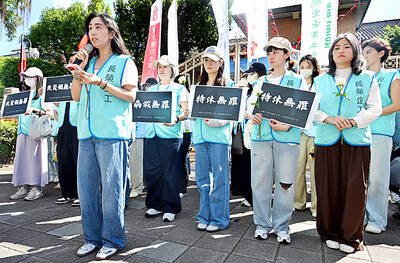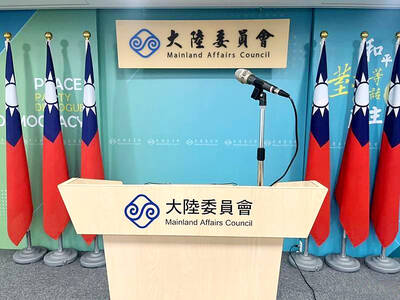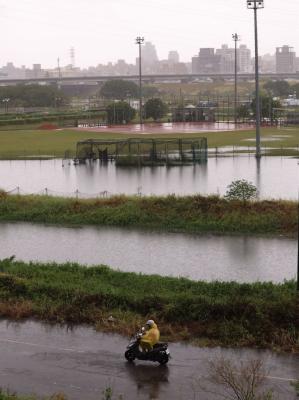Hundreds of demonstrators yesterday thronged the streets of Taipei to commemorate the 56th anniversary of the 1959 Tibetan Uprising and express solidarity with Tibetans in exile.
Waving Tibetan flags — also called snow lion flags and seen as symbols of Tibetan independence — the marchers accused the Chinese government of infringing upon the human rights and religious freedom of Tibetans.
The demonstrators paid tribute to the 1959 uprising, which led to the flight of the Dalai Lama and the establishment of the current Tibetan government-in-exile in Dharamsala, India.
Headed by a coalition of Tibetan advocacy groups and Taiwanese human rights organizations, the protesters also paid respect to more than 130 Tibetans who have self-immolated since 2009 to protest what they call the Chinese occupation of Tibet.
The procession drew a diverse crowd of different nationalities, as monks draped in maroon-and-yellow robes walked alongside Taiwanese supporters dressed in traditional Tibetan garments.
Activists in Tibet face a common threat with those in Hong Kong and Taiwan: repression of human rights by the Chinese government, Taiwan Association for Human Rights Secretary-General Chiu E-ling (邱伊翎) said.
The theme of this year’s parade, “Next Stop: Tibet,” refers to mass protests that began in Taiwan and Hong Kong last year, she said, adding that pro-democracy activists from both sides of the Taiwan Strait must stand in solidarity with Tibetans in their human rights campaign.
The theme also conveys organizers’ hope for Tibetans to be allowed to return to their homeland, as the Dala Lama and his followers have been barred from entry into China for more than five decades, organizers said.
They accused President Ma Ying-jeou’s (馬英九) administration of ignoring China’s treatment of Tibetans and urged the government to take a stand on the issue.
“While Taiwan and China establish ever-closer economic ties, Taiwan’s government has failed to stop the Chinese government from massacring Tibetans,” Green Party co-chair Lee Ken-cheng (李根政) said.
After walking from Taipei’s Zhongxiao-Fuxing MRT station, the demonstrators lay down on the pavement together in memory of the self-immolated Tibetans when they reached Sun Yat-sen Memorial Hall.
Dhundup Gyalpo, secretary of the Tibet Religious Foundation of His Holiness the Dalai Lama — the Tibetan government-in-exile’s de facto embassy in Taiwan — said the event’s main purpose was to honor the pain and suffering that Tibetan activists endured.
Although Beijing has begun to loosen up on restrictions that barred Tibetans from attending religious events, Taiwan Tibetan Welfare Association vice president Tenzin Namda said he considers recent reforms to be mostly superficial, as key teachings of Buddhist philosophy are still banned.
Beijing has attempted to prevent Tibetans from learning their culture, which centers on Buddhist philosophy and ideas of universal compassion, he said.

The Taoyuan Flight Attendants’ Union yesterday vowed to protest at the EVA Air Marathon on Sunday next week should EVA Airway Corp’s management continue to ignore the union’s petition to change rules on employees’ leave of absence system, after a flight attendant reportedly died after working on a long-haul flight while ill. The case has generated public discussion over whether taking personal or sick leave should affect a worker’s performance review. Several union members yesterday protested at the Legislative Yuan, holding white flowers and placards, while shouting: “Life is priceless; requesting leave is not a crime.” “The union is scheduled to meet with

‘UNITED FRONT’ RHETORIC: China’s TAO also plans to hold weekly, instead of biweekly, news conferences because it wants to control the cross-strait discourse, an expert said China’s plan to expand its single-entry visa-on-arrival service to Taiwanese would be of limited interest to Taiwanese and is a feeble attempt by Chinese administrators to demonstrate that they are doing something, the Mainland Affairs Council said yesterday. China’s Taiwan Affairs Office (TAO) spokesman Chen Binhua (陳斌華) said the program aims to facilitate travel to China for Taiwanese compatriots, regardless of whether they are arriving via direct flights or are entering mainland China through Hong Kong, Macau or other countries, and they would be able to apply for a single-entry visa-on-arrival at all eligible entry points in China. The policy aims

Taipei, New Taipei City, Keelung and Taoyuan would issue a decision at 8pm on whether to cancel work and school tomorrow due to forecasted heavy rain, Keelung Mayor Hsieh Kuo-liang (謝國樑) said today. Hsieh told reporters that absent some pressing reason, the four northern cities would announce the decision jointly at 8pm. Keelung is expected to receive between 300mm and 490mm of rain in the period from 2pm today through 2pm tomorrow, Central Weather Administration data showed. Keelung City Government regulations stipulate that school and work can be canceled if rain totals in mountainous or low-elevation areas are forecast to exceed 350mm in

EVA Airways president Sun Chia-ming (孫嘉明) and other senior executives yesterday bowed in apology over the death of a flight attendant, saying the company has begun improving its health-reporting, review and work coordination mechanisms. “We promise to handle this matter with the utmost responsibility to ensure safer and healthier working conditions for all EVA Air employees,” Sun said. The flight attendant, a woman surnamed Sun (孫), died on Friday last week of undisclosed causes shortly after returning from a work assignment in Milan, Italy, the airline said. Chinese-language media reported that the woman fell ill working on a Taipei-to-Milan flight on Sept. 22